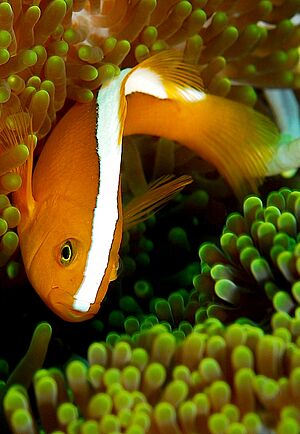Orange skunk clownfish facts for kids
Quick facts for kids Orange skunk clownfish |
|
|---|---|
 |
|
| Conservation status | |
| Scientific classification |
The orange skunk clownfish, also called Amphiprion sandaracinos, is a bright orange fish. It has a wide white stripe down its back. This stripe goes from its top lip, between its eyes, and all the way to its tail.
Like other clownfish, it lives in a special partnership with sea anemones. This partnership is called a symbiotic mutualism. The anemone's stinging tentacles do not hurt the clownfish. The clownfish helps the anemone too.
These fish are special because they are sequential hermaphrodites. This means they can change their sex during their life. In a group, the biggest fish is always the female. The next biggest is the breeding male. The other males are smaller. If the female dies, the breeding male changes into a female. Then, the largest non-breeding male becomes the new breeding male.
Contents
About the Orange Skunk Clownfish
The orange skunk clownfish is one of the smaller types of clownfish. Females can grow up to 11 centimeters (about 4.3 inches) long. Males are usually smaller, from 3 to 6.5 centimeters (about 1.2 to 2.5 inches).
This fish has a body that looks strong and oval-shaped. It is flat on the sides. Its bright orange body has a white stripe on its back. This stripe starts at its upper lip, goes between its eyes, and ends at the base of its tail. All its fins are orange like its body, except for part of its dorsal fin, which is white. Its eyes have bright yellow irises.
Where They Live and Their Home
The orange skunk clownfish lives in the central Indo-Pacific area. This region is also known as the Coral Triangle. You can find them from the Philippines to Indonesia and New Guinea. They also live in northwestern Australia, Christmas Island, Melanesia, and the Ryukyu Islands in southern Japan.
These fish usually live in small groups. They prefer the outer slopes of reefs or in lagoons. They can be found at depths up to 20 meters (about 65 feet).
Host Anemones and Their Partners
Clownfish do not just pick any sea anemone to live in. They are very specific about their hosts. The orange skunk clownfish mostly lives in one type of anemone:
- Stichodactyla mertensii (Mertens' carpet sea anemone) – This is their usual host.
- Heteractis crispa (Sebae anemone) – They rarely use this one.
Sometimes, on the northern coast of New Guinea, male orange skunk clownfish breed with a much larger female clownfish called Amphiprion chrysopterus. When they do, their babies are a special type of hybrid clownfish called Amphiprion leucokranos.
In 2011, scientists saw something unusual. Three orange skunk clownfish and two Amphiprion clarkii clownfish were living together in one Stichodactyla mertensii anemone. The A. clarkii fish were not mean to the orange skunk clownfish. But they did chase away other fish that came near their anemone. The clownfish did not divide the anemone into separate areas.
What They Eat
Like all clownfish, the orange skunk clownfish eats many different things. This means they are omnivorous. Their diet includes tiny animals floating in the water, called zooplankton. They also eat small benthic crustaceans that live on the seafloor. And they munch on algaes.
Protecting the Orange Skunk Clownfish
Clownfish and their host anemones live on coral reefs. These reefs face many environmental problems. Anemones, like corals, have tiny living things inside them called zooxanthellae. These help them get food. But if the water gets too warm or too acidic, anemones can get sick and turn white. This is called bleaching.
Another danger to clownfish is being caught for aquariums. Clownfish make up a big part of the global trade in marine aquarium fish. While some are bred in captivity, many are caught from the wild. This can lower the number of clownfish in certain areas.
Bleaching is a big threat to both clownfish and their anemones. But catching fish for aquariums can make the problem worse in areas already affected by bleaching.
In 2012, the orange skunk clownfish was checked for the IUCN Red List. It was listed as a least concern species. This means that while there are local threats, they are not a big danger to the total number of these fish around the world.
Orange Skunk Clownfish in Aquariums
The orange skunk clownfish and their host anemones are sometimes collected for the aquarium trade. These clownfish have also been successfully bred in captivity.


